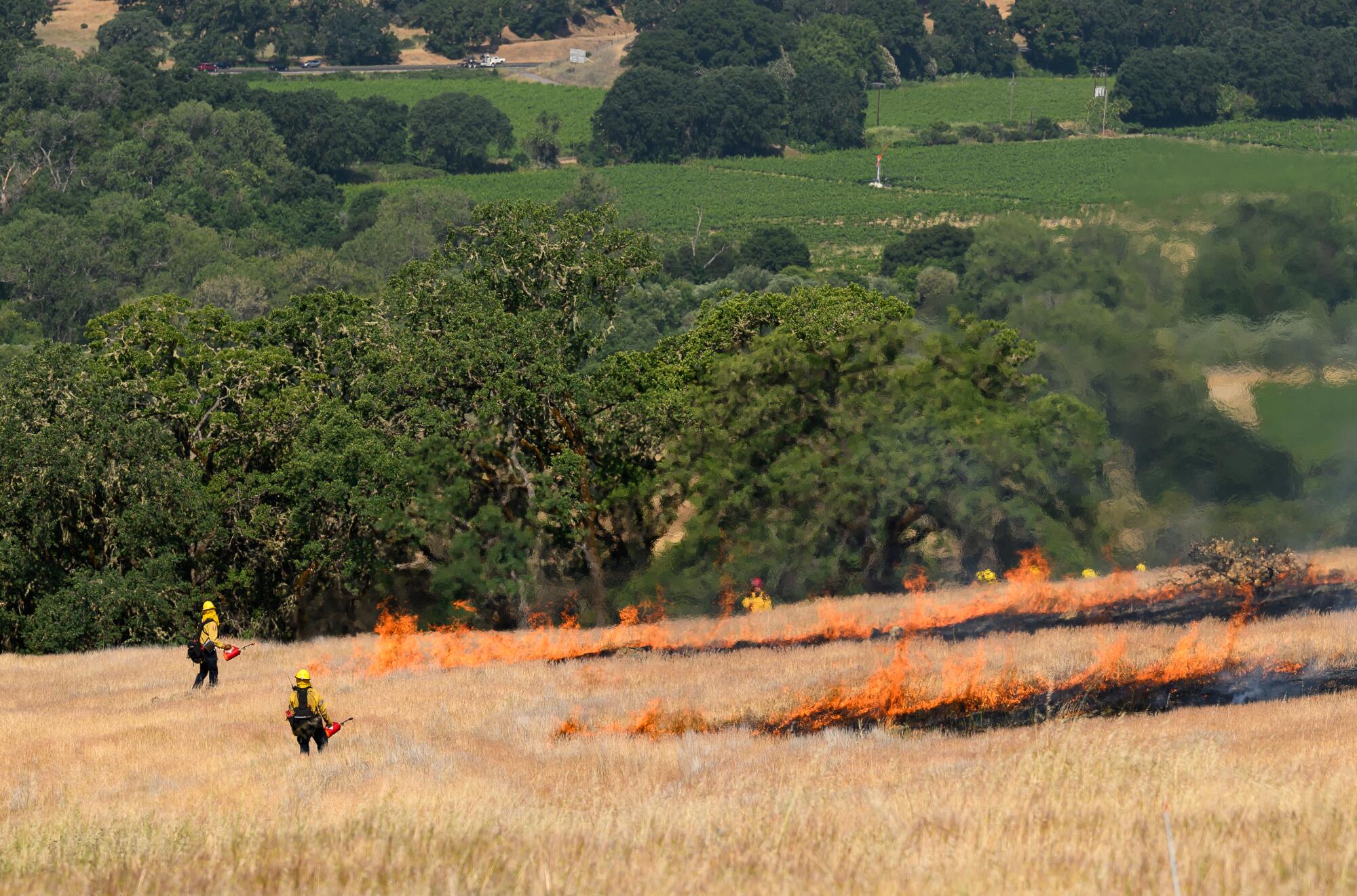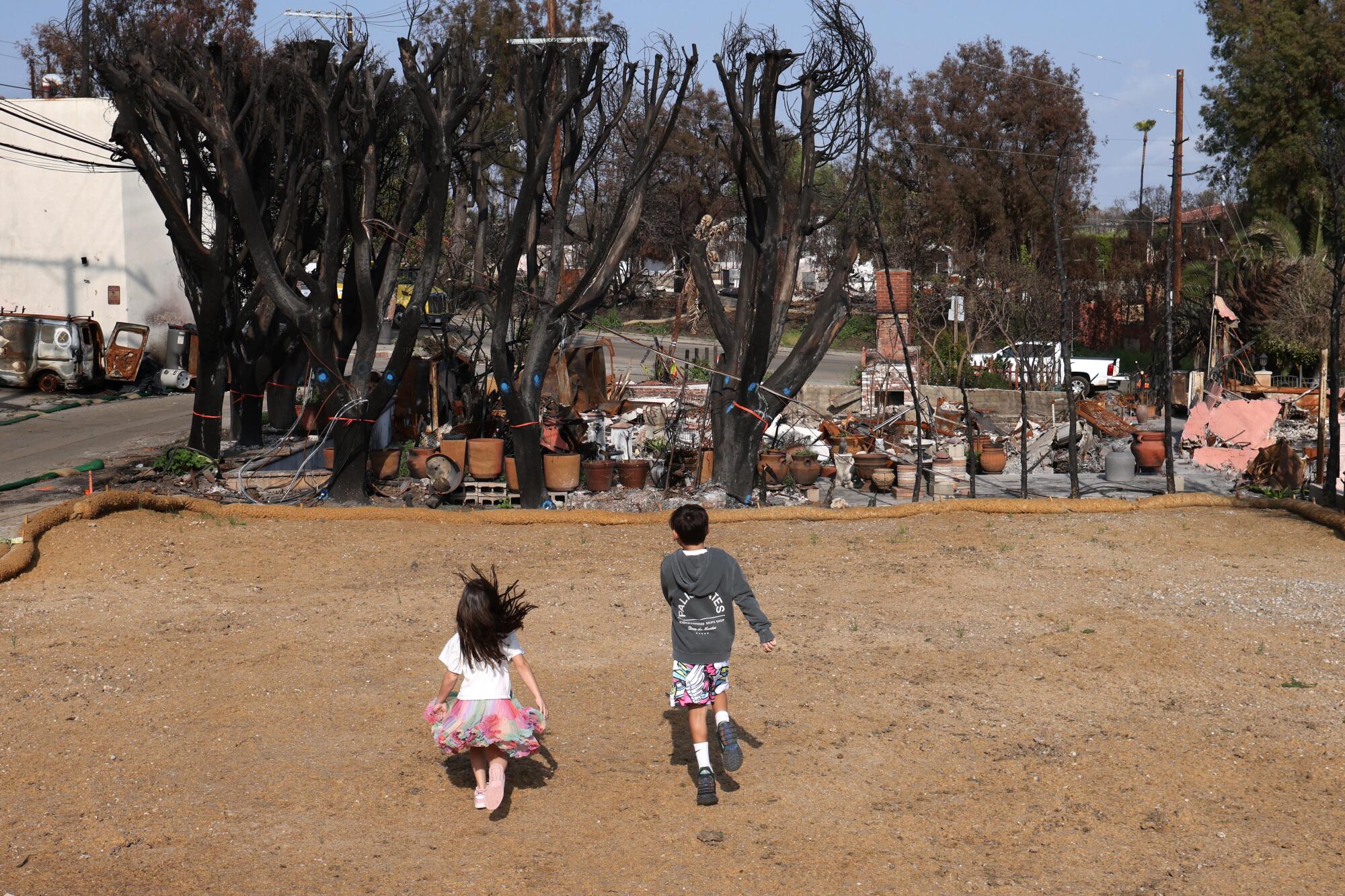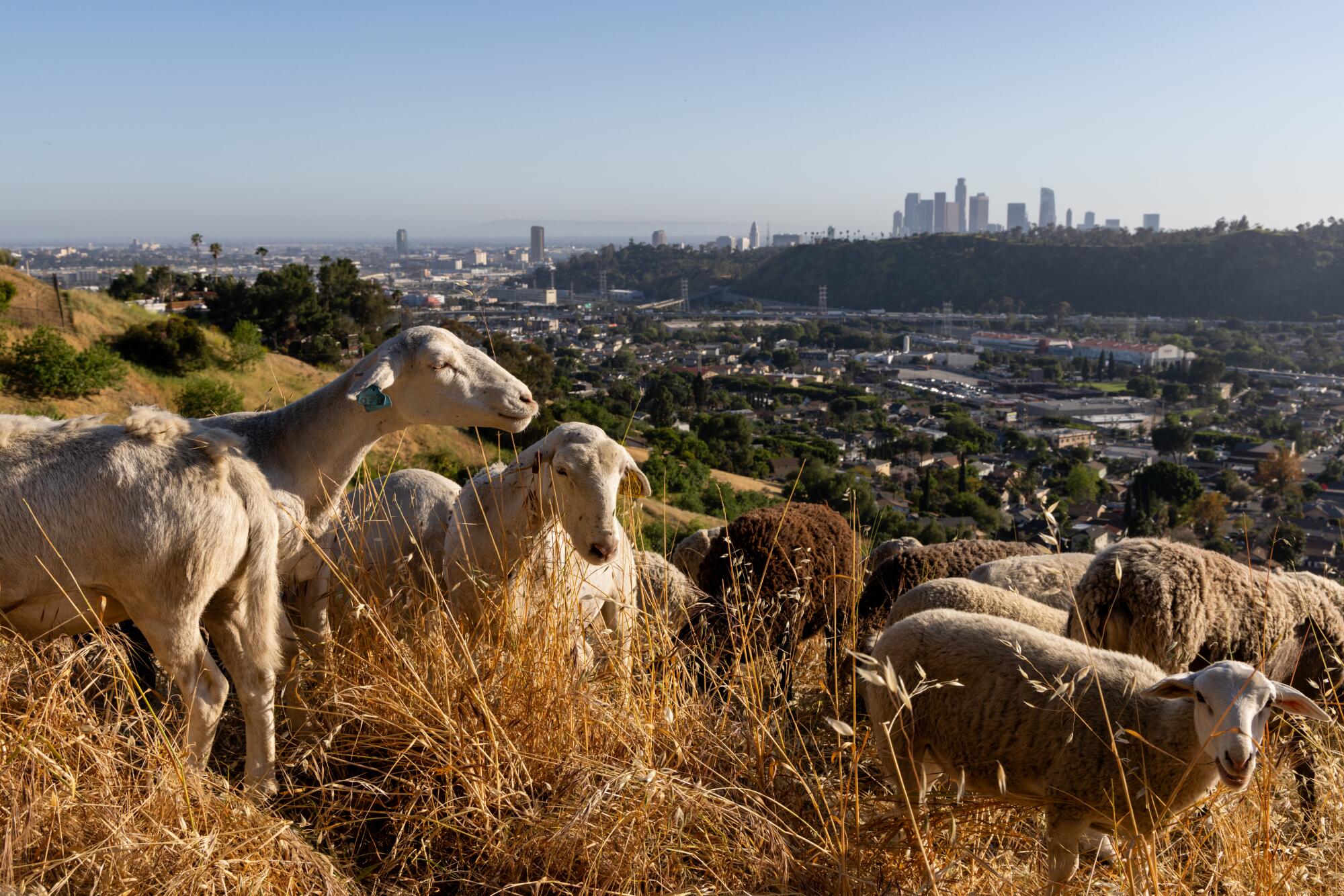As California continues to reel from the historic firestorm that decimated portions of Los Angeles in January, the state is now facing the prospect of an exceptionally active wildfire season fueled by hot, dry conditions. It may not be ready: Experts say sweeping changes at federal agencies that play key roles in California’s wildfire preparation and response could make a challenging season even worse.
The latest forecast from the National Interagency Fire Center calls for above-normal fire activity across much of California and the Northwest through September. The government outlook warns of “significant fire potential” in Northern California, the Sierra Nevada and several of the state’s coastal areas due largely to a pronounced warm and dry trend.
The forecast arrives as the Trump administration is enacting budget cuts, layoffs, office closures and restructuring at the U.S. Forest Service, the National Oceanic and Atmospheric Administration and the Federal Emergency Management Agency. Trump has said the changes will help eliminate federal waste and save Americans’ tax dollars.
However, these three agencies are critical components of California’s wildfire response capabilities, from forecasting and forest management to firefighting and disaster relief. Weakening them at the start of fire season — and at a moment when human-caused climate change is driving larger and more destructive blazes — puts California at a dangerous disadvantage, multiple experts said.
Goats and sheep graze on top of Kite Hill in Los Angeles for fire prevention on May 8.
(Juliana Yamada / Los Angeles Times)
“The level of anxiety is so extreme among people who understand the consequences of converging crises,” said Daniel Swain, a climate scientist with the University of California Agriculture and Natural Resources.
The combination of a bone-dry winter, an early and rapid spring snowmelt, and a forecasted anomalously hot summer raises the risk of intense fire activity across the region, he said. When coupled with new federal policies that decrease the state’s ability to foresee, prepare for and respond to wildfires, it could spell disaster.
“It isn’t just NOAA, it isn’t just the Forest Service, it isn’t just FEMA,” Swain said. “It’s every single one of these agencies, departments and entities that would be helping us either preemptively prepare or emergently respond to wildfire events and other kinds of disasters — all of which are dysfunctional at exactly the same moment.”
The U.S. Forest Service oversees more than half of the forestland in California and represents the largest federal firefighting entity. The Trump administration has called for a 63% budget cut at the agency and a reduction of as many as 10,000 employees, or roughly 30% of its workforce.
Agency officials say firefighters are exempt from layoffs and buyouts.
“The Forest Service continues to ensure it has the strongest and most prepared wildland firefighting force in the world,” said Larry Moore, a spokesman for the U.S. Department of Agriculture, which oversees the Forest Service, in an email. There are nearly 11,000 wildland firefighters on board for the season, including about 3,500 in the Pacific Southwest region that includes California, agency data show.
However, the Forest Service’s ranks also include scientists that study landscape and fire conditions, crews that help clear flammable vegetation through mechanical thinning and prescribed burns, and other employees that manage machinery, technology and operational necessities — categories that were not protected from the staff reductions.
What’s more, approximately 1,400 workers known as “red card” employees were also among those who left or were fired this year. The red card holders are not full-time firefighters, but are certified to deploy to blazes and assist with firefighting operations and response. Officials are now scrambling to call them back.
“It takes resources and capacity to manage our forests, and right now this administration is choking off the agency,” said Josh Hicks, conservation campaigns director with the national nonprofit the Wilderness Society. “There’s not going to be the staff, whether it’s the on-the-ground staff or staff that might be more behind the scenes, to address all the needs that our forests have.”
The changes at the Forest Service aren’t limited to staffing. President Trump has ordered the expansion of resource mining and oil and gas drilling in the nation’s forests and public lands. In April, the administration opened 112.5 million acres of federal forestland to industrial logging in an effort to increase domestic timber supplies. The order includes all 18 of California national forests.

Cal Fire firefighters work a prescribed burn near Hopland, Calif., on June 3. With all of the cuts to the U.S. Forest Service, such efforts to reduce the fuel available for wildfires are being scaled back across broad swaths of the state, leading local fire officials to worry we could be in for a nightmarish fire season.
(Josh Edelson / For The Times)
Hicks said directing the agency to extract more resources from the landscape while simultaneously reducing its staff and budget will further hamper its ability to prepare for and respond to fires this year.
“I think we’ll find out soon enough if … diverting and reprioritizing what the agency ought to be working on is going to be a major distraction,” he said.
The president has also proposed a drastic restructuring that would transfer much of the Forest Service’s wildfire personnel to a new department located within the Department of the Interior, according to his 2026 budget plan. The change would reallocate the Forest Service’s firefighting budget to the new agency and fundamentally reorient its mission to one of extraction and recreation.
“We are getting back to the basics of managing our national forests for their intended purposes of producing timber, clean water, recreation, and other necessities for the American taxpayers,” agency head Tom Schultz said in a statement ahead of a budget review hearing with the U.S. Senate Appropriations Committee last week. Schultz, a Trump appointee, is a former timber industry executive.
Sen. Jeff Merkley (D–Ore.) said during the hearing he was concerned about the implications of such changes for fire season, noting that his state saw a record 1.93 million acres burn last year.
“What happens if those fires are all happening all at once? And what happens if [a] longer, hotter, drier summer produces more fires than last year?” Merkley said. “Instead of investing more in wildfire prevention and firefighting, this budget slashes those investments.”
FEMA has been plagued by similar upheaval in recent months, also losing about 30% of its workforce through an estimated 2,000 workers who were laid off or took buyouts. President Trump has called for eliminating the agency altogether as part of a larger strategy to shift disaster response responsibilities away from the federal government and onto the states.
In a statement to The Times, FEMA officials said the agency is committed to ensuring Americans get the support they need in an emergency, but that “disasters are best when they’re managed at the state and local level.”
Last month, FEMA’s acting director, Cameron Hamilton, was ousted one day after testifying in Congress that he did not think it was in the best interest of the American people to dissolve the agency. He was replaced by David Richardson, who vowed in a recent staff meeting to “achieve the president’s intent.”
As with the Forest Service, experts say the turmoil at FEMA could have considerable ramifications for California. Its Fire Management Assistance Grants are often the first federal lifeline during a fire and have in the past covered up to 75% of the state’s costs for equipment, personnel and other immediate firefighting needs. After a fire, FEMA typically operates disaster recovery centers, provides public assistance funds, and helps coordinate infrastructure repair, debris removal, shelters and other forms of aid.
That is now likely to change.
“The scope and the capacity of the agency has been very intentionally narrowed,” said Jeffrey Schlegelmilch, an associate professor of practice at Columbia Climate School who specializes in national disaster preparedness. As a result, he said, federal disaster relief is only likely to become more rare in the months ahead.
Still, Schlegelmilch said there has been broad bipartisan support for reforming FEMA, and that many experts agree that states should do more to prepare for disasters. But “where we do need to see states spending more, we don’t necessarily need to see the federal government spending less,” he said.
Indeed, FEMA’s programs are already seeing funding cuts and reduced capabilities across the country, including in Los Angeles, where the agency broke with tradition and declined to fund soil testing following the Palisades and Eaton fires earlier this year.

Mandana and Justin Sisco visit the site where their home once stood with their children, August, 7, and Marley, 5, in Pacific Palisades on April 23.
(Genaro Molina / Los Angeles Times)
The Trump administration also eliminated FEMA’s Building Resilient Infrastructure and Communities grants, which help states prepare for disaster. Trump’s proposed plan would slash an additional estimated $646 million from the agency’s overall budget.
States don’t have much time to prepare for such a potentially rapid loss of federal support. It’s not clear whether FEMA will even exist come wildfire season. Trump has said he would like to wind down FEMA after this year’s hurricane season, which ends in November — just as California’s fire season typically peaks.
“It’s going to be a very, very rough road for many states under this new paradigm,” said Schlegelmilch.
When it comes to California’s increasing battle against wildfires, those new challenges begin well ahead of disaster response.
The Trump administration has also targeted NOAA and its subsidiary, the National Weather Service, for cutbacks. NOAA provides the foundation for much of California’s wildfire preparedness, as its forecasts and warnings are often the first indication of trouble ahead and a signal for government agencies to begin positioning resources.
The president’s recent directives have roiled NOAA, which is facing a potential budget cut of roughly $1.5 billion following recent layoffs of more than 1,000 employees, including many meteorologists and other scientists, and the gutting of research programs. Officials this year have already suspended the launch of weather balloons at several locations across the country.
At least two NWS offices in California no longer have enough staff to operate overnight: Sacramento and Hanford, which together cover the Central Valley and the Sierra, among the state’s most fire-prone regions.
When asked whether the agency can assure the public that recent changes will not affect its ability to forecast fire conditions and alert the public to danger, NWS spokesperson Erica Grow Cei said only that officials are taking steps to refill roles at key locations through short-term temporary duty assignments and reassignments.
“Additionally, a targeted number of permanent, mission-critical field positions will soon be advertised under an exception to the department-wide hiring freeze,” she said.
Swain, of the University of California, said the loss of personnel, expertise and redundancies at NOAA and the NWS put the state’s residents and firefighters at a considerable disadvantage as fire season ramps up.
While cracks may not show on an ordinary weather day, “the problem is when there is an extreme event or a disaster or an emergency,” he said. “That’s where people are going to mess up and make mistakes — not on purpose, not due to lack of training or lack of professionalism, but because they’re being asked to do 200 things simultaneously, and all of them are life-and-death critical.”
Compounding all of these challenges is the fiery forecast for this summer and fall.
The wet winters of 2022 and 2023 prompted new vegetation growth across California, which subsequently baked under recent dry conditions. The NIFC outlook notes that precipitation in Central and Southern California has been about 70% below average since October.
All that dry brush will meet with a remarkably hot summer across California and the West, which could lead to explosive fires, Swain said. He is particularly concerned about the national picture between August and October, when there is an overlap between peak fire season and peak hurricane season.
“This year is ringing a lot of alarm bells, and would be ringing alarm bells even if we had fully functional, fully funded federal agencies,” Swain said.

A person takes a scenic hike on a hot, sunny day through the hills near Frank G. Bonelli Regional Park in San Dimas on May 9.
(Allen J. Schaben / Los Angeles Times)
At the state level, officials say they are doing what they can to prepare for an active fire year.
The California Department of Forestry and Fire Protection has been steadily adding more personnel in recent years and now employs more than 12,500 people with a goal to increase staffing to 14,500 over the next few years, according to David Acuña, battalion chief of communications at the agency’s headquarters in Sacramento.
Acuña acknowledged that conditions are ripe for a dangerous summer and fall. “It’s a haystack of dry fuels that are just waiting to burn,” he said. However, when asked about changes at the federal level, he demurred.
“There’s a lot yet to be known,” he said. “We don’t really know. What we do know, though, is that when there is a fire, if Cal Fire is called upon, we will be ready and able to respond immediately.”
Indeed, Cal Fire isn’t only adding staff but is also expanding its firefighting capabilities through partnerships with other nonfederal entities, he said. Among them is Earth Fire Alliance, a nonprofit coalition launching satellites that analyze the landscape and search the state for wildfire activity.
Another project known as ALERT California, which is operated by Cal Fire and UC San Diego, uses artificial intelligence to scan more than 1,000 remote mountaintop cameras for the first signs of sparks.
While such efforts may help reduce California’s reliance on the federal government, they can’t fully replace its assets yet. For example, Acuña said Cal Fire depends on red flag warnings and other data from the NWS to position crews, and it often fights side-by-side with firefighters from the Forest Service.
“We rely on our local partners, tribal partners, federal partners,” he said. “Even as large as we are, we still can’t do it alone.”




